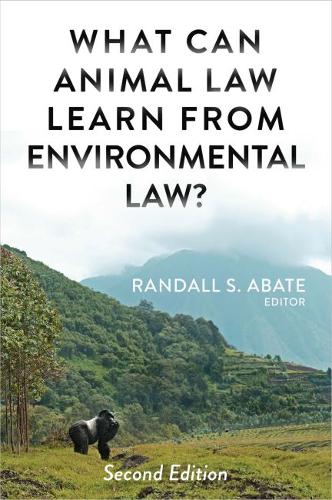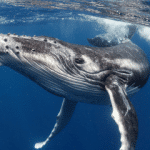
Review by Randi Milgram, A-LAW Blog Editor and Companion Animals SIG Co-chair
The book “What Can Animal Law Learn from Environmental Law?”, now in its second edition, is at once a legal textbook (though a fairly accessible one) and a call to action. It’s a veritable treatise on the answer to the title question, as well as the answer to the reverse. Professor Abate’s well-curated book features 29 chapters of dense research and compelling arguments, each written by established professors and leaders of their fields. The wisdom in comparing and combining the two areas of law is clear – both defend those unable to defend themselves; both require creative thinking; both face similar hurdles of political legitimacy in the public eye. But the extensive lessons that we in animal law can learn from the environmental movement are examined with such considerable legal support that it makes the connection undeniable and the applicable guidance an imperative.
This second edition comes after victories in 2016 against SeaWorld and Ringling Bros., and after several high-profile lawsuits on the issue of personhood, including from our friends at NhRP. It also includes new chapters on rights of nature initiatives and their potential to help animal law progress, and on ‘animal socioequality’ to enhance animal protections through an environmental justice lens. The new edition also capitalises on the growth in both fields in regards to food law and policy, and it expands its coverage of climate change. Each chapter is written and researched by different experts, mainly professors of law (including Joyce Tischler, about whom the A-Law blog has written before), usually two per chapter. This means that the writing style changes in subtle (and not so subtle) ways, and some parts feature more persuasive or inspiring writing than others. But every chapter is researched impeccably.
Some of the most important information for a non-U.S. reader to understand is in the foreword, in which professor David Favre explains the striking differences between environmental and animal law in the United States. Readers must learn about the distinct positions of the two fields before getting to the core of the book. From legislation to litigation, from state to state, the processes of the two fields are worlds apart in strength and decades apart in progress. As is the case in many other jurisdictions, in the USA environmental advocates have more legal tools at their disposal than animal advocates do. In the 1970s, the USA enacted major federal environmental laws, and established agencies to enforce them. Showing commitment to these developments, many statutes contained citizen suit provisions, authorising citizens to file a lawsuit against these agencies and private parties in the event of alleged violations of the statutes. Crucially, the laws provided for the recovery of attorney’s fees for successful lawsuits. So, when government or private parties broke the law, citizens could bring suit without worrying about losing everything.
Unfortunately, animal law is weak not only in comparison, but objectively. Practice of animal law in the USA (or UK) has none of the above procedural benefits of environmental lawsuits, and is not a national issue. In the USA, animal law exists in a rather piecemeal fashion, differing from state to state with no real national focus. No state, not one, allows for recovery of attorney’s fees for animal lawsuits; neither does the Animal Welfare Act, one of the few national pieces of legislation, which has little bite. An essential contrast between the two fields is their reach: The federal environmental laws cover all primary causes of harm, all major polluters within the EPA’s regulatory power, all manufacturers, any player seriously affecting the environment. In contrast, the scope of the AWA stops well short of touching the commercial animal industry, the area where the most help is needed. So, while the federal environmental laws made sure to cover the players who could pose the biggest risks to the environment, federal animal law made sure to do the opposite.
The differences between the two areas of law seem unending, from the contrasts in international visibility and treaties to the general public acceptance of the need to improve their strength. People in general know why they should care about the environment: it affects them in tangible ways. Humans are self-interested for the most part, so getting majorities to care about animal well-being is an unending struggle; it doesn’t mean anything to people if they don’t already care. The book points out the false perception that stronger protections for animals would lead to weaker protections for humans. But even if people didn’t have this fear, many still don’t see the reason to care for stronger protections. On the other hand, environmental law benefits from 50 years of growth, during which it established its legitimacy, something animal law is in the early stages of. Both fields have more mainstream and more extremist segments, such as the animal welfare versus animal rights ideologies. Environmental law established itself and became mainstream by being patient and advocating in an low-key, more widely acceptable fashion, and only now can the movement shift into higher gear, as we’ve seen with climate change advocacy. Abate instructs that animal law would benefit from the same enduring (or long-suffering) path – the more mainstream acceptability of welfare gaining more ground and legitimacy before rights can be recognised. And while this is undoubtedly true, I can’t help but think that this waiting decades patiently for environmental law to not disrupt the status quo too much, this waiting for people to get around to accepting that something more powerful needed to be done, contributed to the position we are in now — with experts saying it’s too late to actually accomplish anything regarding climate change, too late to reverse it. From the animal law perspective, waiting for real change is an actual death sentence, and advocates would say the longer we wait, the more individuals will suffer and die.
However urgently progress is needed, the lessons of this book are accurate in how we can go about achieving any success, as truly every small step forward counts. The book is divided into four units. The first unit examines the historical, political, and legal foundations of environmental law, with both lessons to follow and mistakes to learn from. It begins with an in-depth look at foundational caselaw with familiar names. Following the extensive legal histories is an analysis of how the cases succeeded or failed in specific aspects (usually standing). Standing is an integral topic in both fields of law, since without personhood of animals or nature, a human plaintiff must prove injury to himself. This intertwining section is particularly enjoyable as it points out all the creative ways lawyers have achieved success in suits when a straightforward path does not exist, such as looking to nuisance law or following qui tam suits (in which a whistleblower with knowledge of fraud committed against the federal government can bring suit on its behalf under the False Claims Act; unfortunately, this method is no longer used in England & Wales).
I appreciated their take on damages, since we all agree that the current system of damages (in both USA and UK) for companion animals is insulting. The writers discuss the appropriateness of compensating for companionship value – not whether or not pets have that, since it’s agreed that they do. Environmental law recognises that nature has value beyond merely economy use, and that natural resource damages should reflect economic and noneconomic values, but courts refuse to recognise companion animal value beyond economic (or how much they cost). Courts can learn from this benefit of environmental cases, if lawyers know how to argue that animals’ value exists in ways “not readily measured by traditional means” (as described in Ohio v. Dept. of the Interior, 1989).
From there, the book contains a comprehensive overview of various legal doctrines in Unit II, including air pollution, animal agriculture, and animal testing, just to name a handful. This is a more straightforward textbook-like part of the book, densely packed with information. Unit III looks at international and comparative law, including trade and treaties like CITES. This section is quite helpful for our purposes, as is Unit IV, which gets into the heart of how we can collaborate between the two areas of law. Possibly the most important section, this part of the book goes over all the similarities, shared interests, and areas of disagreement and debate between animal advocates and environmental advocates. Animal agriculture, namely factory farming, is the most obvious shared area to collaborate in, as these places are terrible for the environment and for the animals captive there.
Important political differences that separate the two fields are discussed, with suggestions on how to work through them. For example, environmentalists still capture the ’60s and ’70s label of being ‘tree-huggers’ or hippies and are mainly seen as being on the left of the spectrum, while animal advocates can reach across the aisle, as we have seen with Conservative Party support in the UK. Although animal advocates say we are environmentalists too, and vice versa, when forced to choose between e.g. protecting a habitat or protecting members of the relevant species, our two groups will not agree.
Although the title suggests that animal law must learn from those in environmental law to match their successes, the book successfully argues that we really should work together. Critical threats to animal well-being and environmental well-being are in large part the same at present, and we could achieve more by combining our efforts, or at least understanding the important issues from the other perspective. Abate’s impressive work points out the mutual benefit we could achieve if we worked together, with the final chapters looking at the difficulty we’ve seen in achieving personhood for animals but the success we’ve seen achieving personhood for parts of nature around the world. Interestingly, the book poses the novel idea of a ‘comprehensive ecosystem personhood’, something that would increase success on all fronts.
For readers who wish to read this book on their own private time, it is dense but worthwhile. But I wish that I could have had a law school course based on reading this book and delving into all the citations in the footnotes, as an advanced option after the meager options of just Environmental Law or just Animal Law. Both fields demand further study and not just overview courses, and the vibrant discussions in this book and the cases supporting the arguments demonstrate how rewarding their operating in concert would be for animals and for the environment.





![R (on the application of Highbury Poultry Farm Produce Ltd) (appellant) v Crown Prosecution Service (respondent) UKSC [2020] 39](https://news.alaw.org.uk/wp-content/uploads/2021/10/News-Blog-Image-25-440x264.png)












